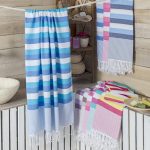Manufacturing Process of Fouta
Peshtemal, also known as fouta, which represent the best features of Turkish Culture in any aspect of life, have a solid 700 year history. Back in the 14th century, when foutas first appeared in the stage of history, producing one single fouta would take weeks and even months. Every loop was weaved one by one by the greatest craftsmen of the era in handlooms which were powered nothing but labor force. Best quality of cotton and the finest madder were used during the production process.
Today, the production process slightly changed. Thanks to automatic looms and weaving machines, mass production became possible. The only thing that didn’t change since the 14th century is our sense of quality. We, as the Peshtemal City, still use the finest staple to be able to provide our costumers with the best quality and the best price.
We have two different departments and over seventy employees. Operating over sixty Switzerland Sulzer Looms and four jacquard looms, Peshtemal City can produce 3.000 – 5.000 peshtemals daily. We have seventeen employees working in 3 different shifts, just for our hotel textile products. Three Dooby Looms and six Jacquard looms are operated during the process, which can manufacture around 30 tons per month. We are also working with contract manufacturers who can supply us around 20 – 35 tons per month.
For the manifucturing process, we are working with the biggest and most qualified dyehouse in Denizli and the masters of their domain, just to make sure that we can provide our costumers with the highest quality of foutas with the shortest amount of time. Our sense of quality has been rewarded with an OEKO-TEX certification.
Thanks to our qualified personnel and hard work of our dynamic research and development team, we are producing not only the best quality peshtemals but also bathrobes, towels and blankets and we are making peshtemal an irreplaceable part of our customer’s daily lives. We manufacture highest quality Turkish Towels for the leading trademarks of Europe, Northern America and Australia. Our peshtemals have the most durable and absorbent texture which makes it perfect for everyday usage.
Peshtemals are replacing normal towels irreversibly in beaches, spas, hotels and even in our homes, and we, as the Peshtemal City, are more than proud to be a part of it.


